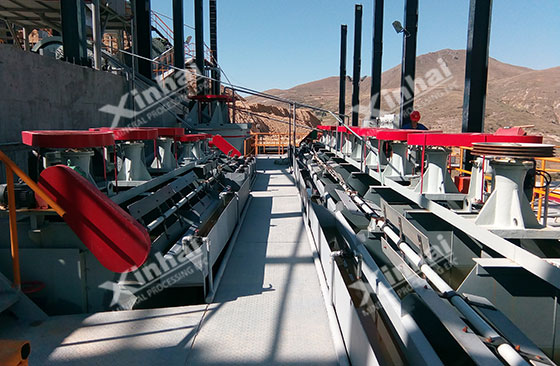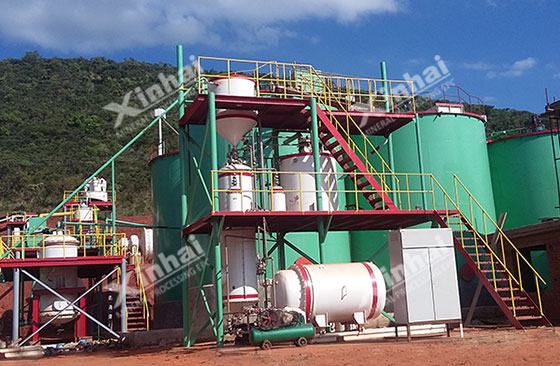
The history has never seen people's faded love for gold. Although it is a common mineral known to people, pure natural gold is rarely seen in nature due to the extremely low content of gold ore and the characteristics of sulfur affinity, copper affinity, iron affinity, high melting point and so on. In the history of mankind, the total output of gold before the 19th century was less than 10,000 tons. While after the 19th century, with the development of science and technology, the gold production experienced a dramatic increase.
At present, the development of the gold extraction process has been relatively mature and complete. In general, the gold extraction process is mainly flotation and gold cyanidation, while the gold cyanidation extraction process can also be divided into carbon in pulp process(CIP), carbon in leaching process(CIL), heap leaching process and so on. This post mainly introduces the comparison between the flotation gold extraction process and gold cyanidation process.
Gold flotation process is a common metal ore beneficiation process, and is also applicable to gold mines. This kind of gold extraction process is mainly suitable for sulfide gold-bearing quartz vein ore, polymetallic gold-bearing sulfide ore and carbonaceous ore with fine gold particles and high floatability. The process of flotation can be divided into a single flotation process, a gravity-flotation combined extraction process, etc., which is a relatively simple gold extraction process. The recovery rate of flotation gold extraction process is considerable. To be specific, the recovery rate of sulfide ore can reach 90%, and a few can even reach 95%~97%; the recovery rate of oxidized ore can reach about 75%, and some can even reach 80%~85%.

Cyanidation gold extraction process is the main modern gold extraction method. It has strong adaptability to gold mines, especially to ores containing clay, graphite, asphalt shale, iron oxide and other natural adsorbents and to other complex arsenic gold ore. The main processes of cyanidation gold extraction process include cyanide leaching, adsorption from cyanide solution, and obtaining the finished gold product, which can be roughly divided into two types. The first type is the so-called conventional cyanidation gold extraction process that is carried out by continuously countercurrent washing with a thickener and then recovering gold with zinc powder precipitation. Another type is filter-free cyanidation carbon in pulp process, which uses activated carbon to directly absorb and recover gold from the cyanidation slurry. Simply speaking, the difference is to recover gold from cyanidation solution by means of zinc powder replacement and activated carbon adsorption, respectively. Cyanidation gold extraction process is more complicated than flotation, but the gold recovery rate is higher. The recovery rate of CIP and CIL can be basically stabilized at 80%, and can be even more than 90%.

Flotation gold extraction process is not only simple in process, but also has a relatively simple requirement in infrastructure and equipment. There is not much difference between single flotation process equipment and other metal ore flotation equipment. In contrast, the complex process determines more complex and strict equipment requirements and infrastructure investment in cyanidation gold extraction process. Therefore, in terms of cost, gold cyanidation is much higher than flotation.
Both flotation and gold cyanidation is chemical extraction processes. Therefore, the reagent is naturally indispensable for the mineral processing process. Various and complex agents need to be used based on a proportion in flotation gold extraction process, like the foaming agent, inhibitor, activator, collector and other agents. While the reagents used in the cyanidation gold extraction process are relatively simple. Cyanide reagents are used in the cyanidation process to leach out the ore. Either of these two gold extraction processes will produce substances that damage the environment. At present, eco-friendly gold leaching reagent has been developed as a substitute for traditional cyanide reagents to reduce the damage to the environment.
Let us take a look at the application of these two gold extraction processes from actual cases. Xinhai mining company undertakes a gold mine flotation project in Cambodia. The dressing plant mainly processes natural gold, but the gold is mostly distributed in arsenopyrite, pyrrhotite and quartz crystal gap, making it difficult to separate gold. Xinhai technical team closely combines with the actual practice according to the mine characteristics and designs a flotation gold extraction line, addressing mine issues including fluctuant raw ore supply and unstable process operation.
In a gold mine in Liaoning Province, China, whose ore is mainly sulfide mineral. The main gold-bearing minerals are pyrite and arsenopyrite with high arsenic content. After the feasibility test, the flotation-cyanidation combined process is adopted. The cyanidation gold leaching process can effectively recover the gold in the arsenopyrite, and the total recovery rate of gold reached 96.37%.
Let us summarize the advantages and disadvantages of flotation and gold cyanidation. The details are as follows:
| Gold Extraction Process | Flotation | Gold Cyanidation |
| Application | Gold particles are finer. The sulfide quartz vein ore, polymetallic gold sulfide ore and carbon ore with fine gold particles and high floatability. The recovery of sulfide ore and oxidized ore can reach 90% and 75% respectively. | It is highly adaptable to gold deposits, including ores containing natural adsorbents such as clay, graphite, asphalt shale, iron oxide and complex gold ores such as arsenic-gold ore. |
| Recovery Rate | The recovery rate of sulfide ore can reach 90%; the recovery rate of oxidized ore can reach about 75%. | The heap leaching method can reach 65%~80%, and CIP and CIL can reach 80%. |
| Advantages | The process is simple, the investment in infrastructure equipment is low; suitable for ore with complex distribution and hard to separate. | The recovery rate is high, and the reagent has eco-friendly substitutes, which can reduce environmental damage. |
| Disadvantages | The use of reagents will have a certain impact on the environment. | The capital construction equipment has high investment; and process is complicated. |
From the examples and comparisons, we can conclude that neither flotation nor cyanidation gold extraction process is a perfect gold extraction process for all mines. When selecting the gold extraction process, we must first conduct a mineral processing test on the mine, and select the most suitable process according to the experimental results and actual conditions. The most suitable one, the better.
To find out more about our products and solutions, please fill out the form below and one of our experts will get back to you shortly.